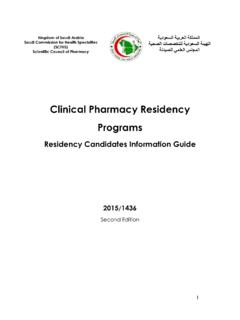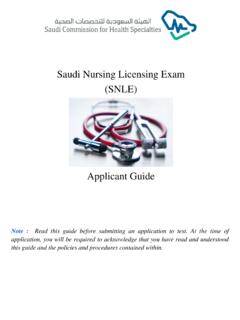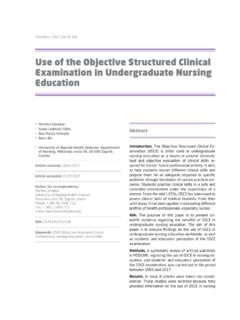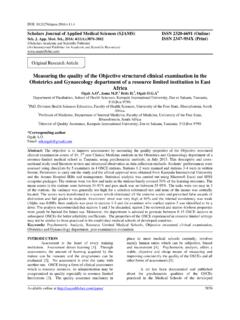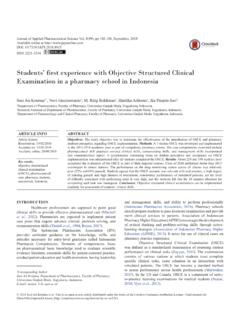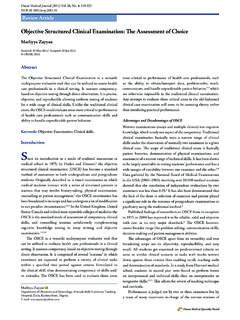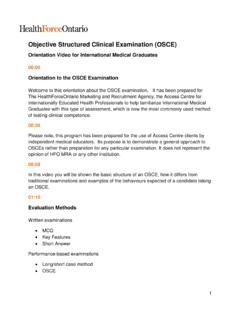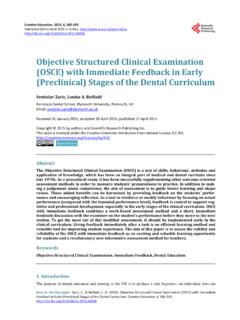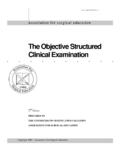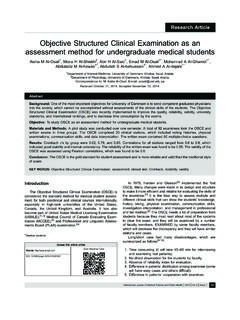Transcription of Objective Structured Clinical Examination - SCFHS
1 OSCE MANUAL 2014 Objective Structured Clinical Examination Saudi Commission for Health Specialties Prepared by: Professor James Ware Professor Abdelmoniem El Mardi Dr Hamza Abdulghani Dr Imran Siddiqui Formatted by: Vittoriana Crisera Saudi Commission for Health Specialties King Fahd National Library Cataloging-in-Publication Data Saudi Commission for Health Specialties, Riyadh - 2014 Objective Structured Clinical Examination 33p; 21cm ISBN: 978-9960-9832-8-8 1- Clinical medicine Diagnosis I-Title dc 1435/9119 no. 1435/9119 ISBN: 978-9960-9832-8-8 TABLE OF CONTENTS OSCE Manual 2014 Page i Preface ii Introduction iii-iv Chapter 1- Relevant principles of assessment 1-9 Clinical Competence 1 Assessment of Clinical competence 5 Characteristics of a good assessment instrument 6 The Objective Structured Clinical Examination (OSCE)
2 7 Chapter 2- Item Construction 10-18 Station s profile 10 Station s opening statement 10 Instructions 11 Scoring and marking form 13 List of resources 14 Stations refinement, calibration and testing - formative OSCEs 15 Preparing the examinee s exam book 15 Recommended standards and regulations 16 Question banking and station materials 17 Chapter 3- Exam Construction 19-24 The Test Blueprint 19 Converting the blueprint into a test map 20 Deciding on types of stations 22 Preparing the exam materials 23 Recommended standards and regulations 23 Chapter 4- Examination Logistics 25-31 Assigning roles and responsibilities 25 Simulated patients/standardized patients 28 Orientation and debriefing of the examinees, patients and observers/examiners 28 Choosing and preparing the venue including the use of video technology 29 Preparing the exam materials 29 Running the OSCE 30 Marking 30 Recommended standards and guidelines for the delivery of the exams 31 Glossary 32-33 PREFACE OSCE Manual 2014 Page ii Preface The Saudi Commission for Health Specialties bears the responsibility for both postgraduate education and assessment standards of specialist training.
3 Following the introduction of postgraduate training in the Kingdom over twenty years ago, the Commission is now undertaking a major overhaul of the programmes offered, the training delivered, their accreditation and finally and very importantly the testing of candidates. There are many challenges ensuring the right standards of care given by our newly certified specialists and future consultants. In this respect the Commission would like to acknowledge the enormously important roles that all our professional colleagues contribute with. It is no secret that there is no one absolute process that can and should be applied to the process of assessment. In this manual often several different solutions are offered for the same purpose and in these cases the individual exam committees will be free to choose their own solutions. The Commission s role is to provide the overall policies and regulations set out in the General Examination Rules and Regulations handbook which is updated and published periodically.
4 We would commend all those who read this manual to read those regulations. The commission has now built three state of the art OSCE centres in Riyadh, Dammam and Jeddah and it is hoped this will encourage all those participating in the important task of examining Clinical competence. Finally I would like to add my sincere words of thanks to those who have contributed to writing this clear and informative manual. Professor Abdulaziz Al Saigh Secretary General The Saudi Commission for Health Specialties Riyadh INTRODUCTION OSCE Manual 2014 Page iii Introduction This manual describes how to plan, construct and deliver an Objective Structured Clinical Examination (OSCE). An OSCE is an examining process made up of a series of stations of equal length set in a circuit. A postgraduate OSCE usually has 10-15 stations each of eight to fifteen minutes. The OSCE is considered to measure Clinical competence and was first created by a group of senior examiners in Glasgow, UK, to replace the undergraduate finals long case, which is inherently unreliable.
5 Since that time the OSCE has been used in postgraduate and national licensing examinations in the USA, UK, Canada and Australia among other countries. The Saudi Commission for Health Specialties has chosen the OSCE to test Clinical competence for the postgraduate medical Saudi Board Examinations. The Commission has also built three OSCE centres in Riyadh, Jeddah and Dammam. It is important that assessment tools are used for their correct purpose, and for example, a Structured VIVA which some confuse with an OSCE, is used to assess reasoning, critical thinking, judgment and application of knowledge. The OSCE is a practical test of medical, or surgical, obstetric and so on, practice. In other words what a specialist will actually do. The Structured VIVA is a theoretical concept and is much more a test of a candidate s intellectual ability.
6 The OSCE is very resource intensive and should not be undertaken by those without experience. This manual is for examiners with some experience of running OSCEs. A second and equally important reason for the manual is to ensure that OSCEs used to certify specialist competence meet the standards required for a valid, credible and defensible test. In the chapters that follow there are details for the hands on construction of a testing process that will meet the Commission s standards for testing postgraduate Clinical competence. Examples of what will meet these standards include the use of a test blueprint, provision of written materials to guide examinees, examiners, patients and simulated patients, equipment lists and grading forms. The planning of an OSCE must begin many months before the delivery date. This will allow for the choosing of examiners, contacting and training of simulated patients, collection of exam materials such as X-rays and common medical equipment required to make stations authentic tests of what is supposed to be measured, for example male catheterization.
7 Training or orientation cannot and should not take place on the same day as the OSCE itself, instead preferably about one week before, so that those being trained do not forget what has been said. There has been considerable evidence reported from research studies which can advise how stations should be run. For example, initially it was thought that two INTRODUCTION OSCE Manual 2014 Page iv examiners at a station would be more reliable than just one. The evidence clearly shows that it is better to use all second examiners to have more stations and thereby increase the reliability of the whole Examination . The way examiners grade candidates is another important issue and whatever details are used it must ensure every candidate is assessed in the same way. In fact this is another characteristic of the OSCE process that all candidates do exactly the same Examination , something that could hardly happen with the long case.
8 Any assessment shall be fit for purpose, in other words an assessment of Clinical competence at medical school graduation level shall determine that successful candidates meet the minimum standards for safe practice. A test of Clinical competence at Saudi Board Part II level is much more about standards of excellence commensurate with the practice of a specialist. It serves no purpose if the OSCE designed for a Saudi Board Part II surgical exam only tests at the level of a graduating medical student, where the core undergraduate curriculum consists mainly of the study of common conditions. A resident is expected to have in depth knowledge of their specialty including unusual conditions. Thus when constructing an OSCE for a Saudi Board Part II exam, counseling a simulated patient over common conditions, such as before an appendicectomy, would probably not be a suitable choice for a station, instead counseling a patient before open heart or parathyroid surgery would make more appropriate tests of Clinical competence.
9 However, the choice of stations stems from the published competencies presented as outcomes of the curriculum/ training participated in. Finally, it will be appreciated by reading this manual that to create and deliver a successful OSCE requires many administrative duties and so those responsible must have these resources to ensure success. All members of the OSCE team will be pleased to assist any group who have been tasked with the duty of constructing an OSCE according to the Saudi Commission standards. The Saudi Commission OSCE Team Professor James Ware Saudi Commission for Health Specialties Professor Abdelmoniem El Mardi College of Medicine Al-Imam University Dr Hamza Abdulghani College of Medicine King Saud University Dr Imran Siddiqui Saudi Commission for Health Specialties CHAPTER ONE: RELEVANT PRINCIPLES OF ASSESSMENT OSCE Manual 2014 Page 1 Chapter One: Relevant principles of assessment Clinical competence Competence A Proper definition of Clinical competence and its components is important to serve as a criterion for validating medical educational programs and to assure a minimum level of competency at the end of medical school and beyond during residency.
10 Webster s dictionary defines being competent as the quality of having sufficient knowledge, judgment, skill, or experience for some purpose. A distinction between competence and performance is often made in the literature. Competence is the possession of the requisite or adequate ability, having acquired the knowledge and skills necessary to perform those tasks that reflect the scope of professional practice. It may be different from performance, which describes what someone is actually doing in a real life situation. Senior (1976), for example, defined competence as what a physician is capable of doing and performance as what a physician actually does. Competencies are a set of professional abilities that includes elements of knowledge, skill, attitudes and experience. Clinical competence A trainee s ability to do what is expected at a satisfactory level of delivery, at a certain point in time, at the completion of the program.
